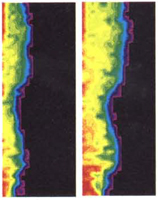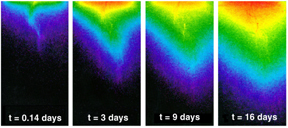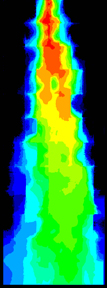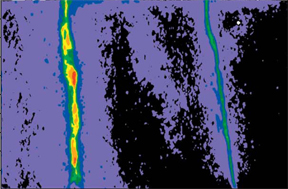Imbibition From A Flowing Fracture

Potassium iodide solution is shown at left imbibing into dry Topopah Spring Tuff, collected near the Yucca Mountain Site. Image at left was taken 1 hour after the start of the test and the image at right was taken after 3 hours. The colors represent relative concentration with red equal to 1. Predicting fluid flow and transport through unsaturated, fractured tuff was of great interest during the design phase of the Yucca Mountain Repository. This experiment verified that imbibition can be modeled as a linear function of the square root of time even when saturated hydraulic conductivity varies over 4 orders of magnitude.
Tidwell, V.T., R.J. Glass, and W. Peplinski, Laboratory investigation of matrix imbibition from a flowing fracture, Geophysical Research Letters, 22:11:1405-1408, 1995.
Visualizing Diffusion Processes

Potassium iodide solution is here diffusing into a fracture at the upper surface of a uniform porosity, brine saturated dolomite sample. Colors represent relative concentration with red equal to 1. X-ray absorption imaging was used to investigate the effects of spatially heterogeneous porosity on matrix diffusion. Experiments were performed on four, centimeter-scale slabs of Culebra dolomite with differring porosity characteristics, taken from the Waste Isolation Pilot Plant (WIPP) site.
Tidwell, V.C., L.C. Meigs, T. Christian-Frear, C.M. Boney, Effects of spatially heterogeneous porosity on matrix diffusion as investigated by X-ray absorption imaging, Journal of Contaminant Hydrology, V42, Issues2-4, 2000.
Fracture-Matrix Network Flow

Potassium iodide solution delivered from a point source at the top of a brick network is captured in the image at left. Color here represents time with red indicating early-time and blue late-time. Further experiments were carried out with this brick network looking at the effect of evaporation and deposition on the behavior of flow pathways.
Glass, R.J., M.J. Nicholl, S.E. Pringle, and T.R. Wood, Unsaturated flow through a fracture-matrix-network: Dynamic preferential pathways in meso-scale laboratory experiments, Water Resources Research, 38(12), 1281, doi:10.1029/2001WR001002, 2002.
Heterogeneous Diffusion

This image represents the porosity of a gouge filled fault within a sample of granodiorite from Japan. The color red indicating a porosity of approximately 14%. The samples contained gouge-filled fractures, recrystallized fracture filling material and hydrothermally altered matrix. Diffusion coefficients were measured.
Altman, S.J., M. Uchida, V.C. Tidwell, C.M. Boney, B.P. Chambers, Use of X-ray absorption imaging to examine heterogeneous diffusion in fractured crystalline rocks, Journal of Contaminant Hydrology, V69, Issues1-2, p1-26, 2004.